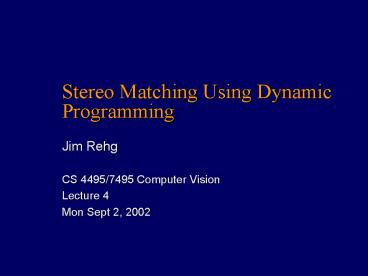Stereo Matching Using Dynamic Programming - PowerPoint PPT Presentation
1 / 19
Title:
Stereo Matching Using Dynamic Programming
Description:
Backtrack from the terminal to get the optimal path. Computing Correspondence Another approach is to match edges rather than windows of pixels: ... – PowerPoint PPT presentation
Number of Views:93
Avg rating:3.0/5.0
Title: Stereo Matching Using Dynamic Programming
1
Stereo Matching Using Dynamic Programming
- Jim Rehg
- CS 4495/7495 Computer Vision
- Lecture 4
- Mon Sept 2, 2002
2
Correspondence
- It is fundamentally ambiguous, even with stereo
constraints
Ordering constraint
and its failure
3
Search Over Correspondences
Left scanline
Right scanline
- Three cases
- Sequential cost of match
- Occluded cost of no match
- Disoccluded cost of no match
4
Stereo Matching with Dynamic Programming
Left scanline
Start
- Dynamic programming yields the optimal path
through grid. This is the best set of matches
that satisfy the ordering constraint
Dis-occluded Pixels
Right scanline
End
5
Dynamic Programming
1
1
1
2
2
2
3
3
3
Principle of Optimality for an n-stage assignment
problem
6
Dynamic Programming
1
1
1
2
2
2
3
3
3
Principle of Optimality for an n-stage assignment
problem
7
Dynamic Programming
1
1
1
2
2
2
3
3
3
Principle of Optimality for an n-stage assignment
problem
8
Dynamic Programming
1
1
1
2
2
2
3
3
3
Principle of Optimality for an n-stage assignment
problem
9
Dynamic Programming
1
1
1
2
2
2
3
3
3
Principle of Optimality for an n-stage assignment
problem
10
Dynamic Programming
1
1
1
2
2
2
3
3
3
Back-chaining recovers the optimal path and its
cost
11
Stereo Matching with Dynamic Programming
Left scanline
- Scan across grid computing optimal cost for
each node given its upper-left neighbors.Backtrac
k from the terminal to get the optimal path.
Dis-occluded Pixels
Right scanline
Terminal
12
Stereo Matching with Dynamic Programming
Left scanline
- Scan across grid computing optimal cost for
each node given its upper-left neighbors.Backtrac
k from the terminal to get the optimal path.
Dis-occluded Pixels
Right scanline
Terminal
13
Stereo Matching with Dynamic Programming
Left scanline
- Scan across grid computing optimal cost for
each node given its upper-left neighbors.Backtrac
k from the terminal to get the optimal path.
Dis-occluded Pixels
Right scanline
Terminal
14
Stereo Matching with Dynamic Programming
Left scanline
- Scan across grid computing optimal cost for
each node given its upper-left neighbors.Backtrac
k from the terminal to get the optimal path.
Dis-occluded Pixels
Right scanline
Terminal
15
Stereo Matching with Dynamic Programming
Left scanline
- Scan across grid computing optimal cost for
each node given its upper-left neighbors.Backtrac
k from the terminal to get the optimal path.
Dis-occluded Pixels
Right scanline
Terminal
16
Stereo Matching with Dynamic Programming
Left scanline
- Scan across grid computing optimal cost for
each node given its upper-left neighbors.Backtrac
k from the terminal to get the optimal path.
Dis-occluded Pixels
Right scanline
Terminal
17
Stereo Matching with Dynamic Programming
Left scanline
- Scan across grid computing optimal cost for
each node given its upper-left neighbors.Backtrac
k from the terminal to get the optimal path.
Dis-occluded Pixels
Right scanline
Terminal
18
Computing Correspondence
- Another approach is to match edges rather than
windows of pixels - Which method is better?
- Edges tend to fail in dense texture (outdoors)
- Correlation tends to fail in smooth featureless
areas
19
Computing Correspondences
- Both methods fail for smooth surfaces
- There is currently no good solution to the
correspondence problem































